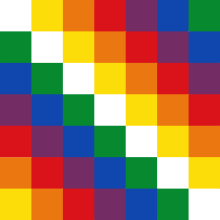Marraqueta
|
The Marraqueta bread can be divided into four pieces with the hands. | |
| Alternative names | Pan de batalla (staple bread) in Bolivia, Pan francés (French bread) and pan batido (“whipped bread”) in Chile |
|---|---|
| Type | Wheat Bread |
| Creator | European immigrants in South America |
| Main ingredients | Flour, salt, water, leavening agent |
| 267 calories for 100 grms. kcal | |
|
| |
The marraqueta (also called pan de batalla ("staple bread") in Bolivia, pan francés (“French bread”) in the south of Chile and pan batido (“whipped bread”) in the Valparaíso Region), is a crispy bread made with flour, salt, water and yeast.
This wheat bread has a crunchy texture,[1] and is very popular in Chile, the Andean region of Bolivia and Peru but can also be found in Argentina and Uruguay.
The Bolivian marraqueta is a 60-75 g bread, sold per unit and consumed mostly in the metropolitan area of La Paz and El Alto. It is prepared in common ovens between midnight and dawn to be sold fresh and crunchy by vendors in the morning.
The Chilean marraqueta is, strictly speaking, a se-tenant pair of small rolls, baked with another pair attached, comprising four rolls in total; some confusion can be caused when ordering one marraqueta, as this may be interpreted as either two or four rolls.
History of Bolivian Marraqueta
The recipe of this crunchy bread arrived in La Paz in 1908 in the hands of the greek immigrant Michel Jorge Callispieris, from Chios island.[2] Bread in both locations share indeed the same characteristics: crunchiness and slightly salty flavor.
The marraqueta of La Paz was declarared cultural patrimony in 2006.
History of Chilean Marraqueta
Many historians agree that the marraqueta originated in Valparaíso, Chile in the late 19th and early 20th centuries, when major Chilean ports such as Valparaíso and Talcahuano received thousands of European immigrants. The story goes the bread was invented by two French baker brothers in Valparaíso whose last name was Marraquette, and the bread went on to become very popular among Chileans in a very short time.[3] This story would explain both the marraqueta and pan francés names. In Valparaíso itself, somewhat confusingly, marraqueta means the four small rolls while half of this is called pan batido, the use of which is a shibboleth of the Port of Valparaíso (but is ignored by national supermarket chains). There is no clear agreement on what is considered one unit of marraqueta and while some bakers claim is the four pieces of bread, some others claim that a unit is only half (so they say that the four pieces are two marraquetas).
An alternative theory of the bread’s origin was proposed by French naturalist and botanist Claude Gay, who suggested that marraqueta was first eaten in Chile in the 18th century.[4]
Currently marraqueta is the most widely consumed bread in Chile and is used as toast,[5] in sandwiches and as a binder for certain recipes such as pastel de carne (meatloaf). It is widely considered the quintessential Chilean staple food.[6]
Ingredients and preparation
Marraqueta is made from flour, water, yeast and salt. It does not contain fat and the proofing process takes longer than other breads. The unusual form of the four buns allows it to be divided very easily.
See also
References
- ↑ "Panes del Mundo. Tradicional Marraqueta". Magazine del Pan. Retrieved 2007. Check date values in:
|access-date=(help) - ↑ http://marraquetasdelapaz.com.bo/. Retrieved July 2016. Check date values in:
|access-date=(help); Missing or empty|title=(help) - ↑ "Panes del Mundo. Tradicional Marraqueta". Venezuela: Magazine del Pan. 2005. Retrieved 2007. Check date values in:
|access-date=(help) - ↑ Gay, Claudio (1865). Historia física y política de Chile según documentos adquiridos en esta república durante doce años de residencia en ella y publicada bajo los auspicios del supremo gobierno. p. 57.
En Chile hay varias clases (de pan) cuyas principales son el pan francés que es el común de la Europa, el pan inglés de forma redonda y un poco menos cocido que el anterior, el chileno sazonado con grasa y generalmente usado en las provincias, la talera que se da a los peones y a los mineros y amasada con la harina en hoja, y enfin la tortilla preparada como al tiempo de Abraham y como la preparan todavía los Árabes y otros pueblos de la África, es decir sin levadura y cocido bajo las cenizas poco antes de la comida.
- ↑ Once: A guide to Chile’s oddly-named evening snack www.thisischile.cl Monday, February 06, 2012 retrieved October 08, 2013
- ↑ Panes del Mundo - Tradicional Marraqueta www.magazinedelpan.com June 06, 2005, retrieved July 29, 2013.

